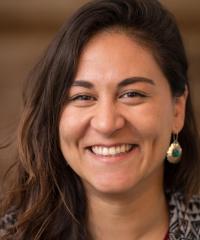
Being seated in an academic institution like UCSB, we understand how important it is to engage with, educate, and learn from our vibrant student community. Every year emLab supports numerous student interns and researchers who make crucial contributions to our research and our culture. Over the summer, we hosted over ten interns and graduate student researchers who supported key research activities for a number of projects in our diverse research portfolio; ranging from forest management to climate policy to fisheries financing. They had an opportunity to share their work with the broader emLab community during a virtual research symposium held at the end of the summer.
Carbon Emissions in CA’s Transportation Sector
This summer, seven interns contributed to emLab’s ongoing project for the State of California. This work is focused on identifying pathways for managing a strategic, responsible decline of transportation-related fossil fuel supply to support the State’s 2045 carbon neutrality goal.
Madeline Oliver (MESM 2021) kicked off the symposium with an overview of policy scenarios that could manage the decline of California's transportation-related fossil fuel supply.These policy scenarios serve as the inputs for a model that quantifies the community-level changes on labor markets and health risks associated with local pollution.
Diving into the specific components of the model, Tyler Cobian (MESM 2020), Danae Hernandez-Cortez (Ph.D. student), and Vincent Thivierge (Ph.D. student) described their ongoing investigation into how different policy scenarios may affect air pollution from the extraction and refining of transportation fossil fuels and, in turn, impact human health. For labor market outcomes, Chris Malloy (Ph.D. student) is quantifying the direct and indirect labor market impacts as a result of the managed decline of extraction and refining of transportation fossil fuels across California.
“I thought working on a project that had the potential to impact the State was very exciting,” said Cobian. “Hearing that the final report would be considered by Governor Newsom and that we could be shedding light on the impact of fossil fuel extraction on marginalized communities was very compelling to me.”
Forest Management, Wildfires, and Carbon Sequestration
Kyle Monper’s (MESM 2020) summer research focused on the relationship between forest management and carbon sequestration in California. Forest carbon storage is another avenue that could help California meet its carbon neutrality goals, but the carbon consequences of forest management as it relates to wildfires is not well-established. Understanding this relationship is important as wildfires become more frequent and intense due to climate change.
Monper explored whether forest management can cost-effectively “store” carbon by avoiding carbon emissions from wildfires. After developing marginal cost curves for forest management, he found that it could cost-effectively store only about 190,000 tons of carbon per year - less than 0.1% of California’s 2017 emissions - in an “extreme” wildfire scenario. The project team concluded that forest management is generally quite expensive for a carbon neutrality strategy, likely to play only a minor role in helping California achieve its carbon neutrality goals.
Fisheries Insurance
We moved from the land to the sea with Nathan Grimes (PhD student), who explored how insurance could be applied to fisheries to help smooth and mitigate the risk of climate change impacts, such as shifting fish stocks. Grimes assessed the utility of Index Based Insurance (IBI), which has primarily been used in agriculture to smooth production losses. IBI payouts are related to an “index” that is closely correlated to production losses. For agriculture, index payouts might be based on rainfall, crop yield or vegetation levels (e.g. pasture for livestock) and payouts are made when the index exceeds a certain threshold. For example, if total rainfall is less than X inches for a given month or year, a payout is triggered.
Grimes built a theoretical model to test the viability of IBI in fisheries, starting with connecting stock biomass fluctuations to changes in environmental parameters, and creating an index of potential shocks and stressors to those parameters. An example of a shock in that index could be “number of bad weather days in a season,” where an insurance payout is triggered once a certain number of bad weather days occurs. The model was refined by testing different insurance contract specifications to determine payout schemes, and by conducting different tests of robustness to determine if/how insurance might alter fisher’s behavior.
Reform and Investment in Indonesian Fisheries
Staying in the fisheries realm, Juan Silva (MESM 2020) highlighted his work with the World Bank on informing fisheries reform and investment in Indonesia. The purpose of this project is to determine the expected joint impacts of investment and management interventions on select Indonesian fisheries in target areas to ensure these strategic investments and interventions yield intended, lasting results.
Silva completed a landscape analysis of Indonesian fisheries to support the parameterization of a bioeconomic model that projects the expected ecological and economic impacts of different reform and investment scenarios.
“Learning about the process of designing and parameterizing novel bioeconomic models was challenging, as was bringing together teams from different organizations and locations around the world into one common goal,” said Silva, “but it is exciting to know that we performed theoretical and applied research that will directly influence actual policy and investment.”
Longline Management in the Federated States of Micronesia (FSM)
We moved to another set of Pacific Islands with Chase Brewster (MESM 2020), who supported an assessment of FSM’s tuna longline fishery management. FSM is a Party to the Nauru Agreement (PNA), a treaty between nine Pacific Island nations to collaboratively manage tuna stocks within the PNA region - which collectively holds about 50% of the global skipjack tuna supply.
The PNA tuna fleet is comprised of purse-seine vessels and longline fishing vessels, both of which are managed using vessel-day schemes (VDS). A VDS involves the lease of vessel-days, a type of permit that grants vessels the right to fish in FSM’s waters for a period of time. While VDS management has been highly effective for the purse-seine fleet, it has failed to deliver the same economic and ecological benefits for the longline fleet. Brewster conducted interviews with fisheries experts in the region as well as a literature review to help identify where issues may exist within current management and potential avenues for improving management. These insights will ultimately culminate in a series of recommendations for FSM.
“Understanding the intricacies and incentives of the complex tuna management systems in the South Pacific was definitely a challenge, but it was worthwhile knowing that our analysis will help FSM and other small island developing states capture more benefits from their rich natural resources," commented Brewster on his summer research experience.



